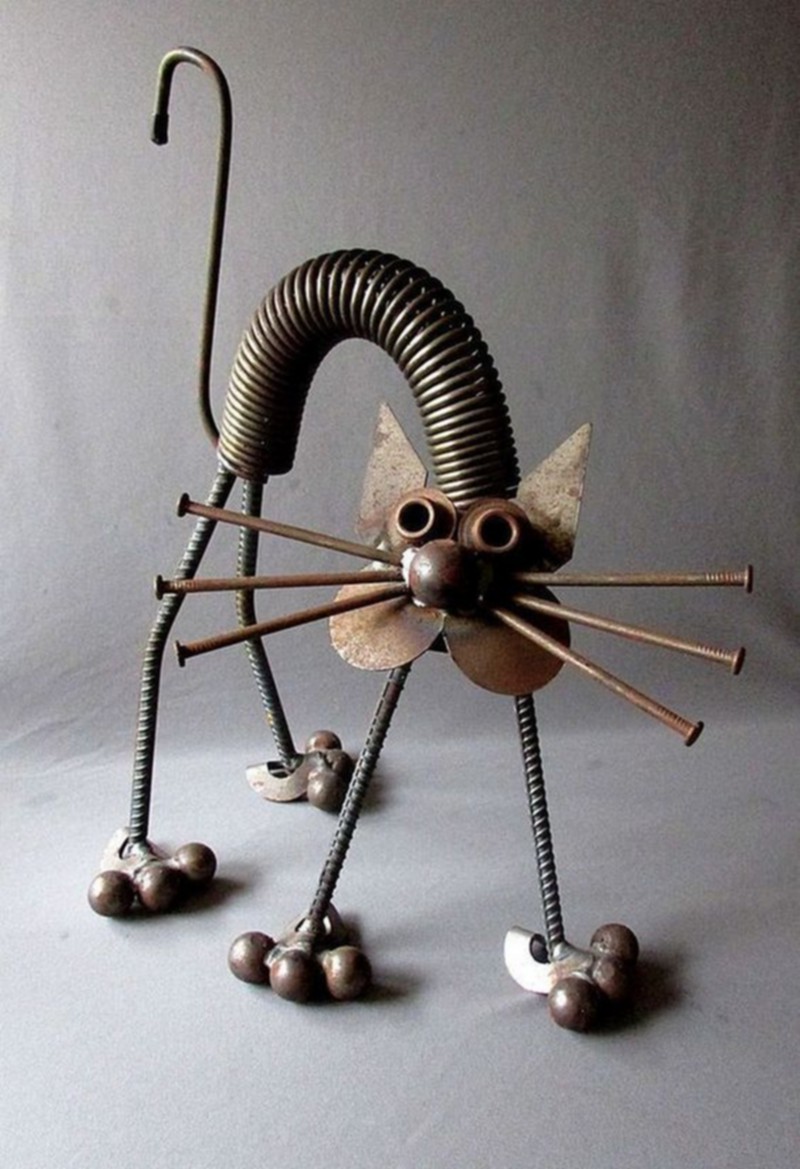40 Creative Scrap Metal Art Craft Sculptures
Scrap metal art craft stands as a testament to the transformative power of creativity, resourcefulness, and environmental consciousness. Originating in the mid-20th century as a response to the surplus of discarded industrial materials, this art form has evolved into a captivating fusion of artistic expression and sustainability. Welding, cutting, and shaping become tools of artistic exploration, allowing discarded metal to be reborn into intricate sculptures and installations. Notable artists like John Chamberlain, Edouard Martinet, and Monogeny Buthelezi have elevated scrap metal art to new heights, challenging conventional norms and contributing to a dialogue on sustainability and societal change. Beyond its aesthetic allure, scrap metal art carries profound environmental implications, offering an alternative narrative on waste and the value inherent in repurposed materials. In marginalized communities, this form of art becomes a beacon of economic empowerment and creative resilience. As a cultural phenomenon, scrap metal art prompts reflection on consumerism, waste, and the potential for renewal within the refuse of progress. Ultimately, this art form invites us to reimagine our relationship with discarded materials, envisioning a world where beauty emerges from unexpected places and creativity becomes a catalyst for positive change.


 Origins of Scrap Metal Art:
Origins of Scrap Metal Art:
The origins of scrap metal art can be traced back to the mid-20th century, where resourcefulness and creativity converged in the wake of industrialization. As industries burgeoned, so did the surplus of discarded metal objects—ranging from machinery parts to automotive scraps. Artists, often driven by economic constraints and a desire for innovation, began to see the potential in these cast-offs, transforming them into striking works of art.
The ethos of repurposing materials is deeply rooted in the concept of found objects and assemblage art. The Dadaists and Surrealists of the early 20th century, including Marcel Duchamp, paved the way for the idea that everyday objects could transcend their utilitarian functions and become art. Scrap metal, with its inherent history and industrial aesthetic, became a compelling medium for artists seeking to challenge traditional artistic norms.



Techniques in Scrap Metal Art:
The creation of scrap metal art is a dynamic process that requires a unique blend of artistic vision, technical skill, and an intimate understanding of the materials at hand. Welding, a fundamental technique in metalworking, is often the primary method used to fuse disparate pieces of metal into cohesive and intricate sculptures. The welder’s torch becomes a brush, and molten metal becomes the medium through which the artist sculpts and shapes their vision.



Beyond welding, cutting and shaping are integral steps in the transformation of scrap metal into art. Plasma cutters, angle grinders, and various hand tools are employed to carve out intricate details, contours, and textures. This process demands both precision and creativity, as artists navigate the inherent challenges of working with materials that were not originally intended for artistic expression.
Surface treatments also play a crucial role in defining the aesthetics of scrap metal art. Patination, rusting, and other weathering effects are often embraced, adding layers of character to the finished pieces. Some artists choose to preserve the raw, industrial appearance of the metal, while others explore techniques like painting or clear coating to introduce color and protect against further corrosion.



Notable Artists in Scrap Metal Art:
The realm of scrap metal art boasts a roster of innovative and visionary artists who have left an indelible mark on the medium. Among these pioneers is John Chamberlain, whose large-scale sculptures made from crushed automobile parts garnered international acclaim. His ability to breathe life into discarded metal, transforming it into dynamic and expressive forms, set a precedent for future generations of scrap metal artists.
Sculptor and welder Edouard Martinet is another luminary in the field, renowned for his meticulously crafted insect and animal sculptures. Martinet’s keen eye for detail and his ability to repurpose the smallest and most intricate components of discarded machinery showcase the transformative power of scrap metal art, turning forgotten fragments into mesmerizing creatures.



South African artist Mbongeni Buthelezi takes a distinctive approach to scrap metal art by using discarded plastic. He melts and manipulates discarded plastic objects to create vibrant and textured artworks, challenging preconceptions about the boundaries of material and artistic expression within the realm of repurposed materials.
The work of these artists and others in the scrap metal art community reflects a shared commitment to pushing the boundaries of artistic expression, redefining the perception of waste, and showcasing the inherent beauty found in the discarded and overlooked.




Environmental and Societal Implications:
Beyond its artistic allure, scrap metal art carries profound environmental and societal implications. In a world grappling with issues of waste and sustainability, the act of repurposing discarded metal into art becomes a powerful statement about resourcefulness and the potential for beauty in unexpected places.
Scrap metal art aligns with the principles of recycling and upcycling, contributing to a more sustainable approach to art-making. By giving new life to materials that would otherwise end up in landfills or recycling facilities, artists in this field offer a compelling alternative to the culture of disposability. The very act of repurposing scrap metal challenges societal norms surrounding consumption and waste, prompting reflection on the value inherent in materials deemed obsolete.



Moreover, scrap metal art carries a socio-economic dimension, often flourishing in communities where economic resources are scarce. Artists who turn to repurposed materials as their medium of choice demonstrate resilience and resourcefulness, using creativity as a tool for economic empowerment. This dynamic interplay between art and economics highlights the transformative potential of scrap metal art as a catalyst for change within marginalized communities.



In a broader cultural context, scrap metal art contributes to the dialogue on sustainability, consumerism, and environmental responsibility. As the global community grapples with the consequences of unchecked industrialization and the depletion of natural resources, the ethos of scrap metal art serves as a poignant reminder that even in the refuse of progress, there lies the potential for renewal and regeneration.











Conclusion:
Scrap metal art emerges as a captivating and multifaceted form of artistic expression, weaving together creativity, resourcefulness, and environmental consciousness. From its humble origins rooted in the surplus of industrialization to the innovative techniques employed by contemporary artists, scrap metal art stands as a testament to the transformative power of imagination and the capacity of discarded materials to transcend their utilitarian origins. Notable artists in the field, such as John Chamberlain, Edouard Martinet, and Mbongeni Buthelezi, have elevated scrap metal art to a realm of profound artistic and societal impact. Their work challenges conventional notions of beauty, repurposes materials in unexpected ways, and engages in a dialogue about sustainability, waste, and the intrinsic value found in the discarded. Scrap metal art, with its fusion of artistic ingenuity and environmental responsibility, invites us to reconsider the narratives woven into the materials we discard. It prompts a reflection on the potential for beauty and meaning in the overlooked and the discarded, ultimately inviting us to envision a world where creativity knows no waste and where art emerges from the remnants of progress.
